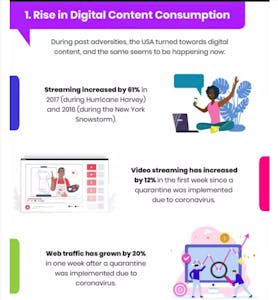- 5 minutes
- Digital Marketing
- Social Media
All Skill Levels
Get a behind-the-scenes-look into FareHarbor's 2024 season

When times are tough, it’s common for individuals and brands alike to struggle with what to say, particularly on social media. Do you stick with your old messaging and approach communications as though its still business as usual? (Hint: no.) Do you commit your feed to only crisis-related posts from now on? (Hint: probably not.) The approach that has proved most successful for brands during the COVID-19 pandemic is to pivot their social media messaging to focus on community and sharing authentic content that is helpful to users, whether it’s stay-at-home tips, heart-warming stories, opportunities to pitch in, or just plain fun.
People have been turning to social media more than ever during self-isolation, so it’s important for brands to continue to have a brand presence. According to eMarketer, Facebook saw a 70% increase in usage of all of its apps in March 2020. People are turning to these apps to keep them entertained, connected, and informed while they’re spending more time at home. While many businesses are scaling back on expenses in all areas, including social media, this time could actually be an opportunity to expand your reach. Continuing and even increasing engagement through social media right now is important to build your brand and connect with customers. This guide will cover why social media matters during a crisis and tips to help you maintain your brand presence and tailor your messaging.
Before we dive into tips, let’s start with why it’s important to maintain a social media presence during a crisis. Of course, there are many aspects of your business that you need to focus on, such as finding ways to cut costs and thinking of ways to bring in revenue. Social media can seem less important in comparison, but it’s an easy and budget-friendly way to connect with your customers, which is crucial during a crisis, as well as afterward.
This applies not only to the current coronavirus pandemic but also to future potential crises – be they financial, natural, or political. Here are a few reasons why it’s a good idea to think about your social media right now, and how to help prepare for future unplanned events.
 You Don’t Need a Budget to Have a Presence
You Don’t Need a Budget to Have a PresenceAlmost every type of business faces budget cuts during a crisis, but social media is a low-budget (if not entirely free) way to continue to capture your audience’s attention and get them to engage with your brand so you’ll be top of mind when it’s time to get back to business — because we know our industry will bounce back. This is a time to understand the need of the hour and create content to meet those demands in a way that best speaks to your audience. Social media is the perfect place to share that content, show your customers that you’re still there for them, and reach new audiences, and you can choose how much to spend on paid posts or take advantage of your organic reach.
 Easy Access for Everyone
Easy Access for EveryoneYour website is one of the primary places for guests to find up-to-date information about your current business status, such as your current hours of operation, what measures you’re taking to provide safe experiences, and other crucial updates for your customers. However, it is generally a more time-consuming process to update your website as compared with opening a social app and posting a quick message. A huge benefit of social media is that it’s a two-way communication tool, allowing your followers to ask questions you can quickly answer and giving them a space to comment on your updates, whether it’s thanking you for being a part of the community or letting you know other ways you could help. Bottom line – social media provides easy access for your followers and customers to stay updated about your business and find important information on a platform where they’re already spending a lot of time.
 Digital Streaming and Online Content Consumption is Dominant
Digital Streaming and Online Content Consumption is DominantIt’s no surprise that people turn to social media and streaming services to stay connected in times of uncertainty. The power of these tools to bring people together in innovative ways is more important than ever when we’re feeling isolated. In past crises, such as Hurricane Harvey, people turned to streaming services to make their time at home a little more fun and less lonely. This infographic from HireInfluence demonstrates how digital platform usage increases during a crisis and why brands should use these platforms to stay connected.

(View the full infographic on their website.)
As you can see, people are consuming more and more digital content, which means brands should be creating more content to reach them. Let’s move onto what you should keep in mind when creating social media content!
 Know Your Audience
Know Your AudienceDifferent social media platforms attract different types of users, so it’s important to understand which platforms best fit your customer demographics in order to have the highest level of reach and impact. If you already have a social media presence across a variety of platforms, you can easily gauge which is the most active and has the most followers by reviewing your account analytics. This information provides you with generalized data about your audience composition, which you can use to decide where to post each piece of social communication. For example, younger users will gravitate to platforms like Instagram and TikTok, while working professionals will most likely be on LinkedIn, and almost all demographics have some presence on Facebook and/or Instagram. Check out the Compass guide where we outline social media accounts every tour operators should use.
 Pro tip: Because there are so many moving parts to consider during a crisis, you may not have the bandwidth to maintain all your social media platforms simultaneously. Consider choosing the top one or two accounts where you have the largest reach and focus your efforts there.
Pro tip: Because there are so many moving parts to consider during a crisis, you may not have the bandwidth to maintain all your social media platforms simultaneously. Consider choosing the top one or two accounts where you have the largest reach and focus your efforts there.
 Figure Out What Resonates with Your Audience
Figure Out What Resonates with Your AudienceDuring any type of crisis, priorities inevitably change. Rather than focusing on what your KPIs (key performance indicators) may have been before the crisis, shift your focus to engagement metrics. Clicks, likes, shares, and comments will prove to be a better measurement of how your customers are engaging with your content than conversions or click-through rates. People might not be willing or able to book a tour or buy a gift card, but if they’re taking the time to engage with your social media content, it’s a good sign that what you’re posting resonates with them and will help build brand awareness. Focus on those metrics and use them to help you determine what type of content helps followers connect with your business.
While every audience is different, there are some types of messaging that work well no matter who your target audience is:
 Try New Things!
Try New Things!Because your typical KPIs and ROI are not as relevant to your overall success on social media during a crisis, you can be flexible and experiment with new types of content you may not have had the time, or confidence, to try before. Your tried and true methods for increasing bookings might not be as useful when people are unable to travel or enjoy your experiences, so take this time to try out new forms of content that are geared toward increasing engagement. Here are a few ideas to get you started:
 Pro Tip: Don’t overwhelm yourself by trying out too many new approaches at once. Instead, start with one experiment, analyze the results (your engagement metrics as well as anecdotal information about your followers’ reactions), and use what you learned from the experience to decide what you should try next.
Pro Tip: Don’t overwhelm yourself by trying out too many new approaches at once. Instead, start with one experiment, analyze the results (your engagement metrics as well as anecdotal information about your followers’ reactions), and use what you learned from the experience to decide what you should try next.
 Be Ready to Pivot
Be Ready to PivotIt might not feel this way in the middle of a crisis – but business will pick back up – so now is the time to plan ahead to be as ready as you can when an unexpected event passes and things have normalized. In conjunction with your social efforts in a crisis, you should also be preparing your messaging for when things change. For a full list of tasks to tackle during a downturn, check out the Compass guide on digital marketing housekeeping items.
If a crisis has temporarily forced you to close your doors, start by drafting the posts you’ll use when your business is open again – getting any copy and images ready so you can just plug and play when the time comes. Think about how you can incentivize followers to do business with you once you’re open again. For example, you can offer a grand re-opening discount to people who share your Instagram post, hold a drawing so a few followers can win a free tour or activity, offer family bundles, or other promotions.
 Finally, consider how your social media will stay the same and how it will need to change once you re-open. Use the insights from your social media experiments during times of crisis to better understand your audience and tweak your messaging. You might find that they respond really well to video, for example, and you can plan ways to incorporate video into your future strategy. Rather than going back to business as usual, be thoughtful about adapting your social media to continue the engagement you fostered during the crisis.
Finally, consider how your social media will stay the same and how it will need to change once you re-open. Use the insights from your social media experiments during times of crisis to better understand your audience and tweak your messaging. You might find that they respond really well to video, for example, and you can plan ways to incorporate video into your future strategy. Rather than going back to business as usual, be thoughtful about adapting your social media to continue the engagement you fostered during the crisis.
In times of crisis, don’t let uncertainty stop you from taking action and being present for your customers. There are opportunities to connect, build community, and even drive purchases during this time for the businesses that are ready, available, and active. Your customers are looking for ways to be social, to connect with others, and even to be distracted from everything that’s going on. Social media is the perfect platform for brands to engage with customers and increase brand awareness now and into the future. For more tips on how to adapt to a crisis, watch our webinar on strategies to increase bookings after a crisis.